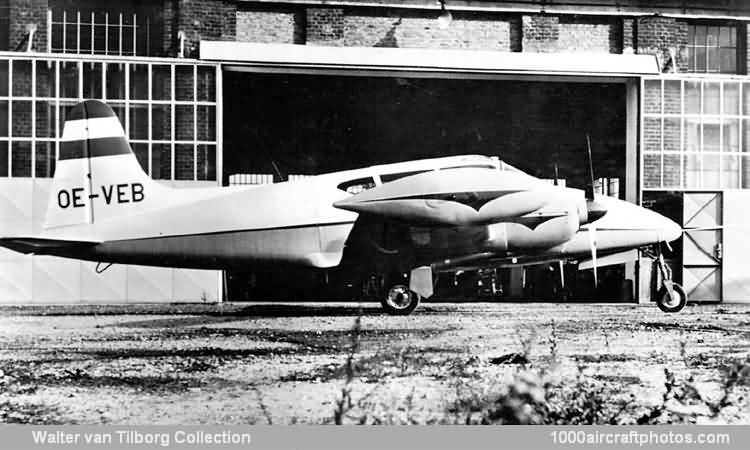The power plant comprised two 150 hp Lycoming O-320-A four-cylinder horizontally-opposed air-cooled engines and all fuel was carried in wing tip tanks. All-wood construction was used for the laminar-flow wings and for the tail unit. The fuselage had a welded steel-tube structure, the forward portion being covered with light-alloy skin and the rear portion with laminated plastic. Normal seating was for four persons, in pairs. The M.222 was aerobatic when carrying a pilot and one passenger.
The prototype M.222V1, registered OE-VEA c/n 1, flew for the first time on May 15, 1959. Unfortunately it crashed during an one engine out test flight on August 2, 1959, the pilot Eduard Stefl and flight engineer Leopold Schwingenschlögl were killed instantly. Subsequently two further prototypes were built in the Rax-Werke in Wiener Neustadt, the pictured
OE-VEB, first flown in 1960 and the M.222V3 c/n 3, first flown in 1962.
The type was redesigned by the glider designer Ruediger Kunz, in order to build the machine in compliance to USA regulations, and hence the fourth prototype was designated SGP.222VS (VS for Vereinigte Staaten, German for United States). Initially registered OE-VED, the aircraft was reregistered OE-FEC after it received its Austrian and FAA Type Certificates on respectively February 15 and March 3, 1964, whereafter it was also redesignated SGP.222A. However, at the end of 1964 the program was cancelled and the prototypes were scrapped."
Span: 36 ft 1 in (11.00 m)
Length: 28 ft 10 in (8.80 m)
Height: 10 ft 0 in (3.05 m)
Wing area: 184 sq.ft (17.1 sq.m)
Weight empty: 2,535 lb (1,150 kg)
Loaded weight: 3,858 lb (1,750 kg)
Max speed: 186 mph (300 kmh) at sea level
Cruise speed: 168 mph (270 kmh)
Landing speed: 70 mph (113 kmh)
Climb: 1,378 ft (420 m)/min
Service ceiling: 20,997 ft (6,400 m)
Range: 808 mls (1,300 km)
